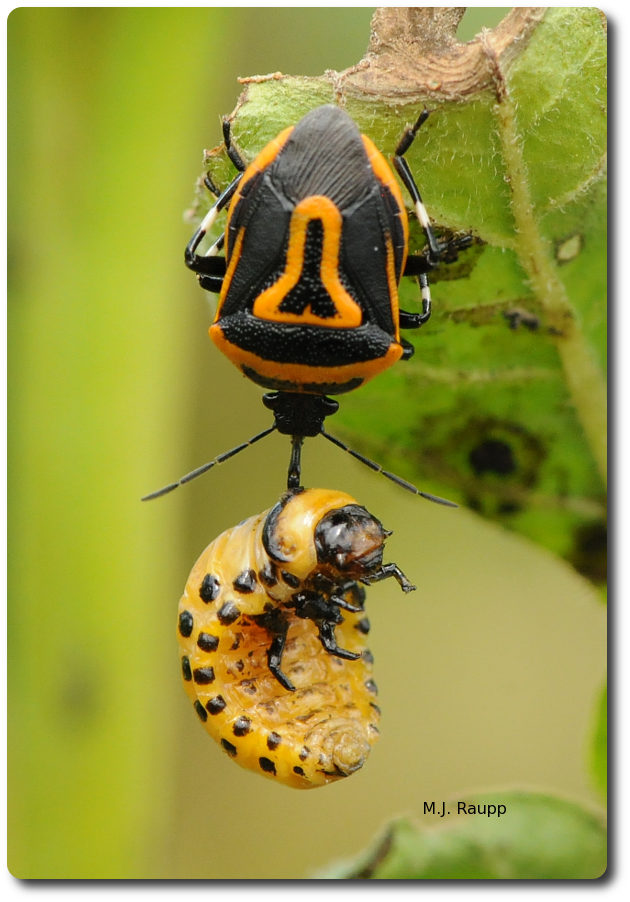During the past month, Bug of the Week visited despicable bed bugs and rising brown marmorated stink bugs. Their proclivity to bite people or valuable crops, respectively, brings misery and economic loss. Not wishing to convey an impression that all bugs are dastardly, this week we turn our attention to a couple of heroes of the true bug clan. Last week while visiting a potato patch, I witnessed droves of Colorado potato beetles eating the tops of plants into nubbins. Prowling around the vegetation were gorgeous nymphs and adults of the two-spotted stink bug, Perillus bioculatus.
The beak of a spined soldier was the last thing to pass through the mind of this caterpillar. Photo credit - John Davidson.
Like their cousins assassin bugs that we met in a previous episode, predaceous stink bugs actively hunt and kill their prey. On a potato plant loaded with beetles, I watched a two-spotted stink bug stealthily approach an unsuspecting potato beetle larva. The actual attack was much less an energy-charged pounce and kill and more of a seemingly gentle poke of the stink bug’s beak. Before the hapless beetle larva could attempt to escape, the proboscis of the stink bug impaled it. After spearing the beetle larva with its beak, the stink bug injected digestive enzymes into its victim. These enzymes help liquefy tissues in the body of the beetle. A muscular pump in the head of the stink bug enables the bug to suck the nutrient rich broth from its prey.
As I wandered around the potato patch, I noticed that only a few plants had potato beetles and an attendant complement of stink bug assassins. Many healthy plants lacked beetles and stink bugs. How do stink bugs locate plants with potato beetles in a vast field of potatoes where many plants have no potential prey? Clever researchers discovered that as potato beetles eat potato plants, the leaves of plants release volatile compounds into the atmosphere. Hungry two-spotted stink bugs on the prowl for prey are able to detect the compounds from beetle-wounded plants and use them as an olfactory beacon to find beetle infested plants that house their prey.
Also on the hunt for meat in the potato patch and a nearby soybean field were spined soldier bugs, Podisus maculiventris. These stabbing predators savor a wide variety of insect prey including beetles, caterpillars, and other bugs. The appetite of these stink bugs for pests is prodigious. Immature stages of the stink bugs regularly eat about five Colorado beetle larva per day over a lifespan of several weeks. Individual spined soldier bugs are reported to eat more than 100 caterpillars over the course of a growing season. Reproduction in these beaky predators is also remarkable with individual females capable of laying well more than 100 to as many as 1000 eggs that hatch into pest-killing nymphs.
In a world where true bugs often get a bad rap and much bad press, take a moment to consider the stealthy heroes that quietly terminate hordes of hungry pests in our crops and gardens.
References
The following fascinating studies were used to prepare this Bug of the Week, “Identification of Volatile Potato Sesquiterpenoids and Their Olfactory Detection by the Two-spotted Stinkbug Perillus bioculatus” by Bernhard Weissbecker, Joop J. A. Van Loon, Maarten A. Posthumus, Harro J. Bouwmeester and Marcel Dicke; and “Comparison of Perillus bioculatus and Podisus maculiventris (Hemiptera: Pentatomidae) as Potential Control Agents of the Colorado Potato Beetle (Coleoptera: Chrysomelidae)” by Judy Hough-Goldstein and D. McPherson. To learn more about predatory stink bugs, please visit the following web sites:
http://uspest.org/potato/stinkbugs.pdf
http://www.nysaes.cornell.edu/ent/biocontrol/predators/podisus.html

